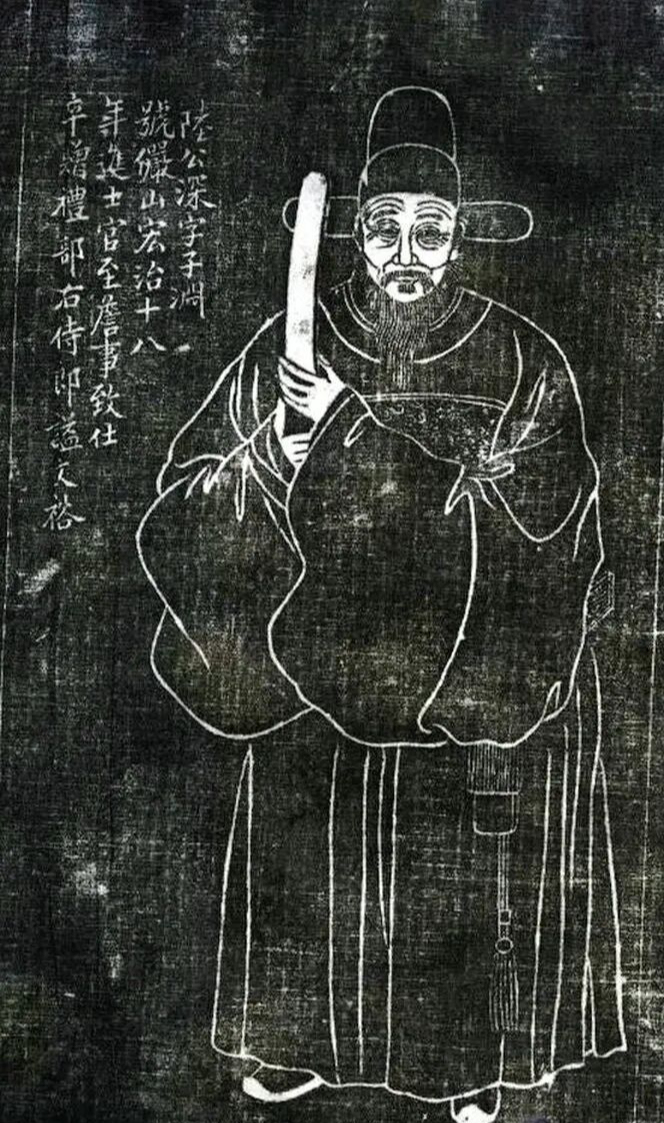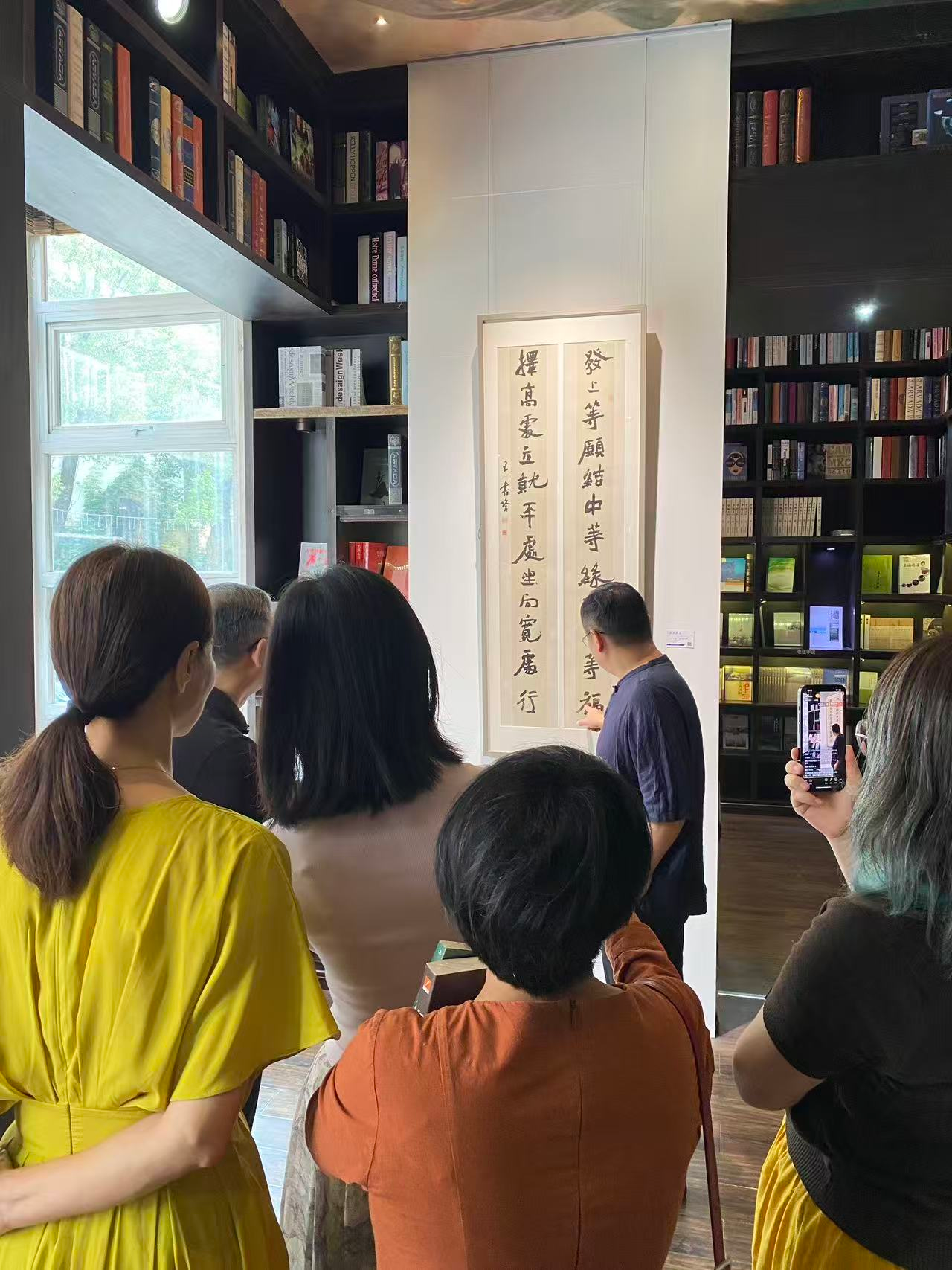
The Paper has learned that starting from September 13th, "Intention to Create a Grand View - Special Exhibition of Song Dynasty Calligraphy and Influence" will be on display at the Zhejiang Art Museum on the bank of West Lake in Hangzhou for a month. The exhibition will display nearly 100 works of famous calligraphers from the Song, Yuan, Ming and Qing dynasties collected by the Palace Museum, Liaoning Provincial Museum, Jilin Provincial Museum, Tianjin Museum, Hunan Museum and other institutions. It is a collection of Chinese calligraphy classics over a thousand years since the Song Dynasty. visual feast.
The exhibition will display masterpieces such as Cai Xiang's "Holding a Book" from the Song Dynasty, Su Shi's "Fengle Pavilion" from the Song Dynasty, Su Shi's "Being Loyalty Viewing Stele" from the Qing Dynasty, Lu You's "Self-written Poems", Zhao Mengfu's "Luo Shen Fu" and other masterpieces. , the original meaning of the exhibition title "Ideology Creates a Grand View" comes from Su Dongpo's "I can't create what I calligraphy means", which is a declaration of the "Shangyi" calligraphy style of the Song Dynasty.
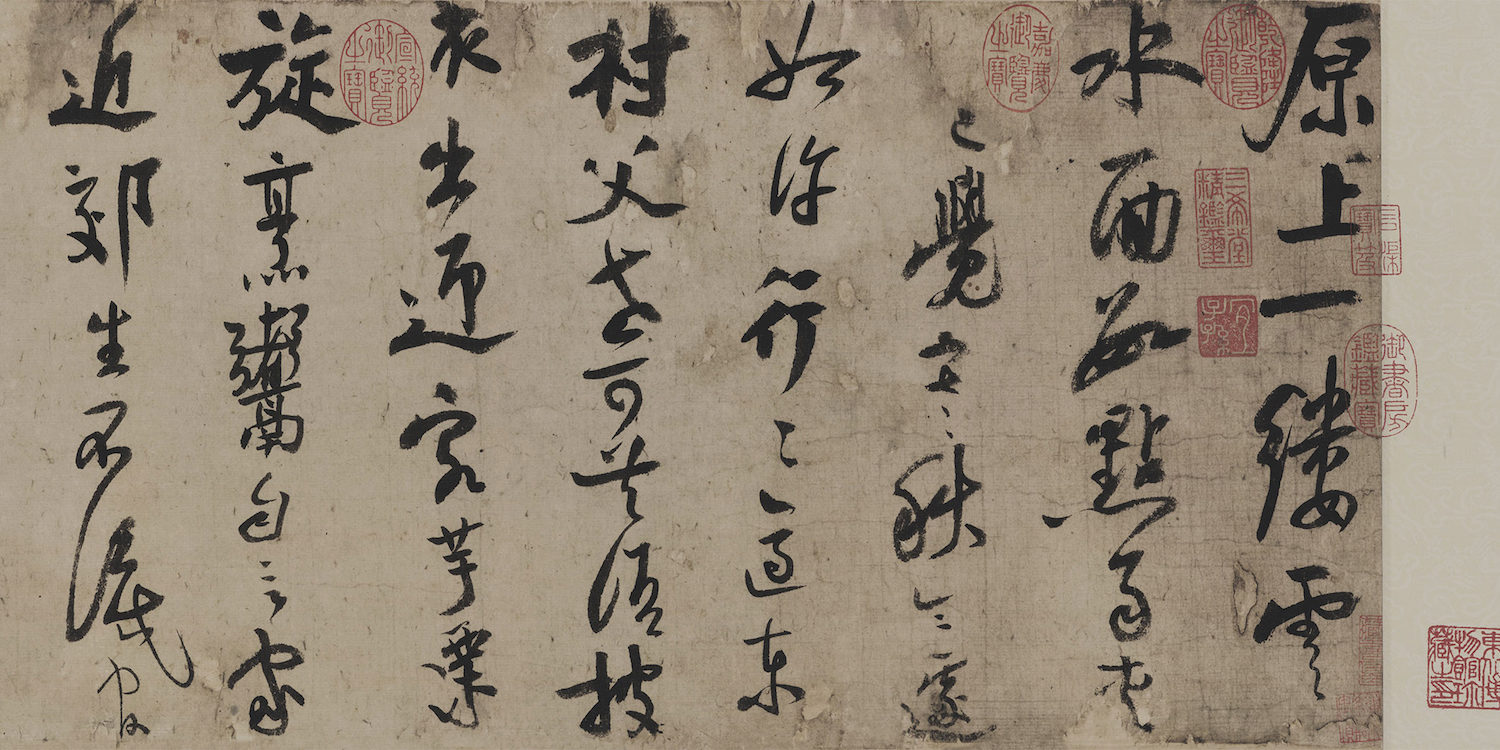
Lu Xing's book "Self-composed Poems" (part), paper, 31 cm long and 701 cm wide, written in 1204, collected by Liaoning Provincial Museum
"Shangyi" calligraphy style refers to the calligraphy style represented by the "Four Song Masters", namely Su Shi, Huang Tingjian, Mi Fu and Cai Xiang of the Northern Song Dynasty, who broke through the barriers of "shangfa" in calligraphy since the Tang Dynasty, promoted the development of calligraphy, and showed the advocating new ideas, The calligraphy style of the times that highlights individuality.
As a special calligraphy exhibition that comprehensively and systematically displays the beauty of the "Shangyi" calligraphy style of the Song Dynasty, the exhibition brings together authentic calligraphy works of the two Song Dynasties from major domestic museums as well as calligraphy of famous calligraphy influenced by the calligraphy of the Song Dynasty (including calligraphy stele rubbings of the Song Dynasty and fine ink ink by famous masters of the past dynasties). ), including 7 first-class cultural relics, 30 second-class cultural relics, and 7 third-class cultural relics.
According to the Zhejiang Art Museum, this exhibition is divided into three sections: "Zhenmin Cui Ying", "My Calligraphy Creation" and "Buyi Liuyan", which respectively display three parts: golden stone tablet rubbings from the two Song Dynasties, calligraphy from the Song and Yuan Dynasties and calligraphy from the Ming and Qing Dynasties. part of the work. Exhibition curator, Zhejiang Art Museum Academic Committee Collection Committee Director, and first-class artist Chen Wei introduced that the “Four Song Schools” have certain historical connections with Hangzhou and have left Hangzhou with rich calligraphy cultural heritage. Hangzhou is undoubtedly “ One of the birthplaces of "Shangyi" calligraphy style.
“Shangyi” and Hangzhou
Hangzhou has an important historical position and role in the history of calligraphy in the Song Dynasty. As the former capital of the Southern Song Dynasty, Hangzhou has a large number of cliff stone carvings and stele rubbings from the two Song Dynasties that have been preserved throughout the West Lake area, with rich content and exquisite inscriptions, reflecting Hangzhou's historical status as the center of calligraphy culture in the Song Dynasty.
In the exhibition, there is a Qing Dynasty ink painting by Su Shi called "The Monument of the View of Loyalty" which is closely related to Hangzhou. It was originally carved in the first year of Yuanfeng (1078) in the Northern Song Dynasty and re-engraved in the Southern Song Dynasty. The remaining stone is stored in the Qianwang Temple in Hangzhou, Zhejiang. The equally famous stone carvings of Dongpo's calligraphy handed down from ancient times include "The Drunkard Pavilion", "Fengle Pavilion" and "Kuichen Pavilion Stele".

Qing dynasty inscription of Su Shi's "Biao Zhongguan Stele" (first opening), originally engraved in the first year of Yuanfeng in the Northern Song Dynasty (1078)/re-engraved in the Southern Song Dynasty, the remaining stone in the Qianwang Temple in Hangzhou, Zhejiang, 141.5 cm long and 83 cm wide (each opening)
The history of "Biaozhongguan Stele" can be traced back to the 10th year of Xining in the Northern Song Dynasty (1077). Zhao Pian petitioned to rebuild the Wuyue Qian Ancestral Hall. Song Shenzong agreed and renamed the original Miaoyin Temple to Biaozhongguan. Praise the Qian family of Wuyue for their merits. The inscription was written and written by Su Shi under the imperial edict, and the stone was erected in August of the first year of Yuanfeng (1078). The stele was located in the Biaozhong Temple in Longshan, Hangzhou, and was moved to Junxiang (today's Stele Forest on Labor Road, Hangzhou) in the 12th year of Zhengde in the Ming Dynasty (1517). Because the Song Dynasty stone was missing, Chen Ke, the governor of Hangzhou, re-engraved the stone in the 36th year of Jiajing (1557) and erected it in the right corridor of Qian Wang Temple (today's Jujing Garden). In the second year of Emperor Qianlong's reign in the Qing Dynasty, he discovered that the stele was slightly exposed under the ruins of the county building. When he excavated it, he found two broken pieces of the stele, the lower part of which was missing. They were the first and fourth stones carved in the Song Dynasty. In the 59th year of Qianlong reign of the Qing Dynasty (1794), the rebuilt Biao Zhong Temple was completed. Qian Yong, the 30th grandson of Qian Liu, moved these two stones from Junxiang to King Qian Temple and listed them in the left corridor of the temple. The exhibits on display are the late Qing rubbings of these two stones.

Qing dynasty inscription of Su Shi's "Biao Zhongguan Stele" (first opening), originally engraved in the first year of Yuanfeng in the Northern Song Dynasty (1078)/re-engraved in the Southern Song Dynasty, the remaining stone in the Qianwang Temple in Hangzhou, Zhejiang, 141.5 cm long and 83 cm wide (each opening)
In the 36th year of the Republic of China (1947), Chen Xijun, an epigrapher, found ten pieces of gravel under the broken wall of the county. He pieced it together and found it to be the second stone of the "Biao Zhongguan Stele" carved in Song Dynasty. It was also moved to Qianwang Temple for preservation. . In the 1960s and 1970s, the Qianwang Temple was used as the Hangzhou Zoo. When the Hangzhou Zoo was built in 1977, the Qianwang Temple was changed to the Jujing Garden. A large number of steles in the original temple were basically destroyed. The Song Dynasty stone carvings of the "Biao Zhongguan Stele" were not able to escape. doom. Currently in the Qianwang Temple, only the first, third and fourth stones were re-engraved by Chen Ke in the Ming Dynasty. According to research by scholars, the original Northern Song engraving of the "Biao Zhong Guan Stele" was destroyed by party bans. It was re-engraved in the Southern Song Dynasty based on the Northern Song original. The remnants of the Song inscription that were rediscovered by Qianlong should have been re-engraved in the Southern Song Dynasty.

Qing dynasty inscription of Su Shi's "Biao Zhongguan Stele" (first opening), originally engraved in the first year of Yuanfeng in the Northern Song Dynasty (1078)/re-engraved in the Southern Song Dynasty, the remaining stone in the Qianwang Temple in Hangzhou, Zhejiang, 141.5 cm long and 83 cm wide (each opening)
In 2020, during the renovation project of the Qianwang Temple in Hangzhou, four remnant stones were rediscovered, with inscriptions on both sides, totaling 33 characters on eight sides. After verification, they were found to be the second stone inscribed in the Song Dynasty and were among the ten remnant stones discovered by Chen Xijun in the Republic of China. The Song Dynasty inscription "Biao Zhongguan Stele" that had disappeared for nearly half a century has been rediscovered.

Qing dynasty inscription of Su Shi's "Biao Zhongguan Stele" (first opening), originally engraved in the first year of Yuanfeng in the Northern Song Dynasty (1078)/re-engraved in the Southern Song Dynasty, the remaining stone in the Qianwang Temple in Hangzhou, Zhejiang, 141.5 cm long and 83 cm wide (each opening)
Also on display at the same venue is Su Shi's "Fengle Pavilion" from the Song Dynasty collected by the Liaoning Provincial Museum. Fengle Pavilion is located at the foot of Ziwei Spring at the foot of Fengshan Mountain in the Langya Mountain Tourist Area of Chuzhou City, Anhui Province. It was built in the sixth year of Qingli in the Northern Song Dynasty (1046) when Ouyang Xiu was demoted to be the prefect of Chuzhou. In the sixth year of Yuanyou (1091), Su Shi was appointed as the prefect of Yingzhou. At the request of the people of Chu, he wrote in large characters and carved stones. His penmanship was profound and powerful, and it was worthy of the charm of Yan Zhenqing's "Dongfang Shuo Painting Praise Stele".

Song extension of Su Shi's "Fengle Pavilion", re-engraved in the Southern Song Dynasty, Chuzhou, Anhui, 32.2 cm long and 21.7 cm wide (each page), collected by Liaoning Provincial Museum
The original stone was destroyed during the Yuanyou party ban in the Northern Song Dynasty. It was re-engraved with woodblocks in the Southern Song Dynasty, which has been lost for a long time. It was re-engraved many times during the Song, Yuan, Ming and Qing Dynasties. There is no original rubbing from the Northern Song Dynasty handed down to the world, and the re-engraved rubbing from the Southern Song Dynasty is the best. The woodcuts of the Southern Song Dynasty are sharp and full of energy, which shows the true face of Su Shi's regular calligraphy. Famous collectors of epigraphic inscriptions and calligraphy in the Qing Dynasty, such as Pan Zuyin and Luo Zhenyu, were proud of having acquired Song copies. The exhibit is a Song rubbing from the old collection of Luo Zhenyu.
In the exhibition, Cai Xiang's "Book Holding Tie", which is stored in the Palace Museum, also has a close connection with Hangzhou. This is a letter he wrote to his brother-in-law when he was the governor of Hangzhou at the age of 54. The content talked about his poor physical condition. It was only two years before Cai Xiang's death.

Cai Xiang's "Holding Calligraphy", paper, 27 cm long and 52.2 cm wide, painted in 1065, collected by the Palace Museum
Cai Xiang was 25 years older than Su Shi and was the senior among the "Four Families of the Song Dynasty". Su Shi admired his calligraphy very much and regarded it as "the best in this dynasty". He connected the calligraphy styles of the Tang and Song dynasties, pursued two artistic pursuits, advocating law and advocating meaning, and played a role in the history of Chinese calligraphy as a link between the past and the future. Cai Xiang's calligraphy theory emphasized spirit, spirit, and rhyme, advocating ancient methods rather than showing off novelty and ingenuity, which had a certain influence on the aspirations and interests of the calligraphy circle in the Song Dynasty.
The Origin, Characteristics and Development of "Shangyi" Calligraphy Style
The formation of the "Shangyi" calligraphy style in the Song Dynasty is closely related to the Zen Buddhism in the mid-Tang Dynasty. Zhang Jizhi of the Southern Song Dynasty and two eminent Zen monks on display this time have historical connections with Jingshan Temple in Hangzhou. For this reason, a sub-exhibition area was set up at Jingshan Temple, "The World Is Broad - Zen Ink Painting Exhibition of the Song, Yuan, Ming and Qing Dynasties". The extant masterpiece "Self-written Poems" by the patriotic poet Lu You of the Southern Song Dynasty is the biggest highlight of this exhibition.
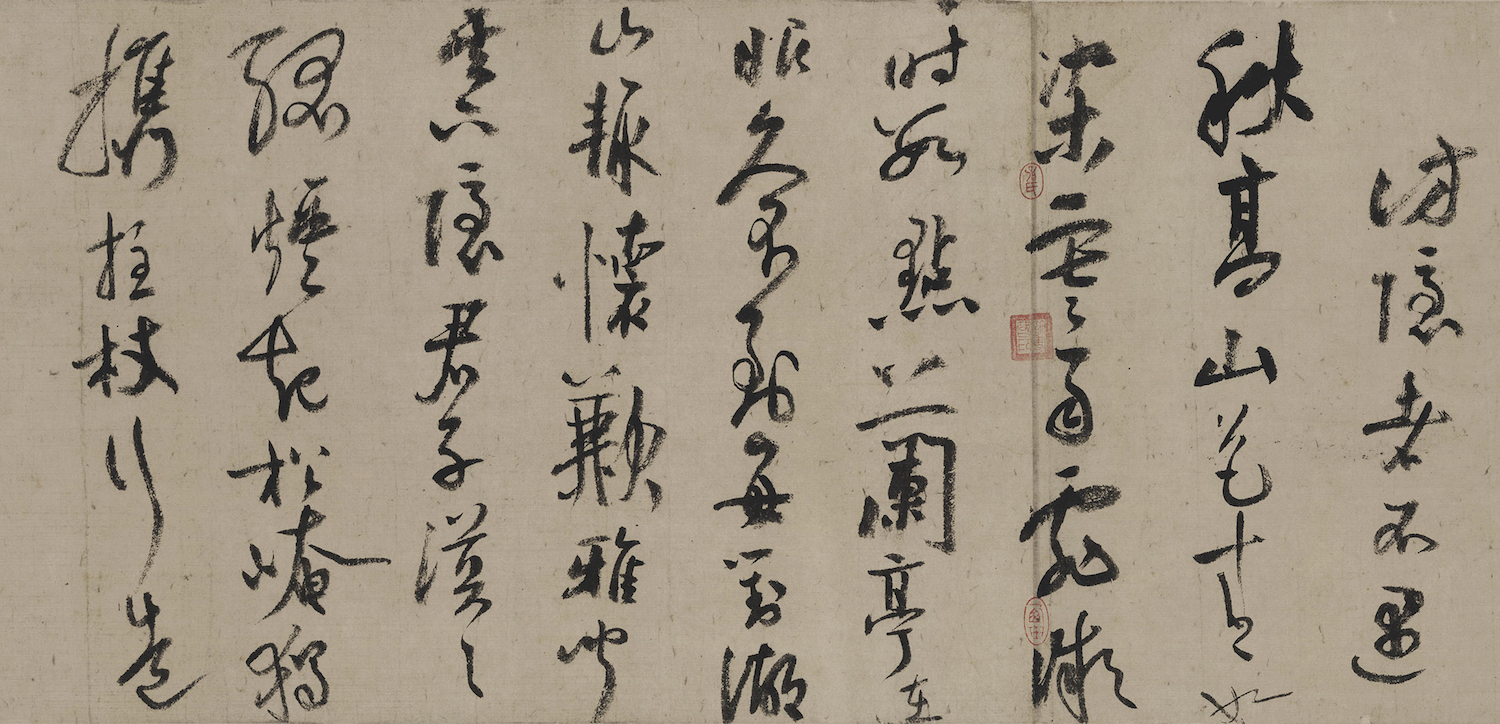
Lu Xing's book "Self-composed Poems" (part), paper, 31 cm long and 701 cm wide, written in 1204, collected by Liaoning Provincial Museum
As one of the four calligraphers of the Southern Song Dynasty (Lu You, Zhu Xi, Zhang Jizhi, and Fan Chengda), Lu You's calligraphy is obscured by his poetry. His cursive calligraphy is modeled after Zhang Xu of the Tang Dynasty, and his running calligraphy is modeled after the Yang Ning style of the Five Dynasties. His calligraphy is elegant and elegant. Judging from this masterpiece in his later years, he applied the ideological realm of "the five mountains are hidden in the heart" in cursive script, which is in line with the spiritual realm of "I create my calligraphy" advocated by Su Shi of the Northern Song Dynasty.
The end of the volume of this work is written by Lu You when he returned to his hometown in Shaoxing at the age of 80 to interact with the village elders. There are 8 poems in total. When you are young, you are relaxed and casual, interesting and lively, unrestrained and energetic, and majestic, like a dragon going out to sea and rolling waves.
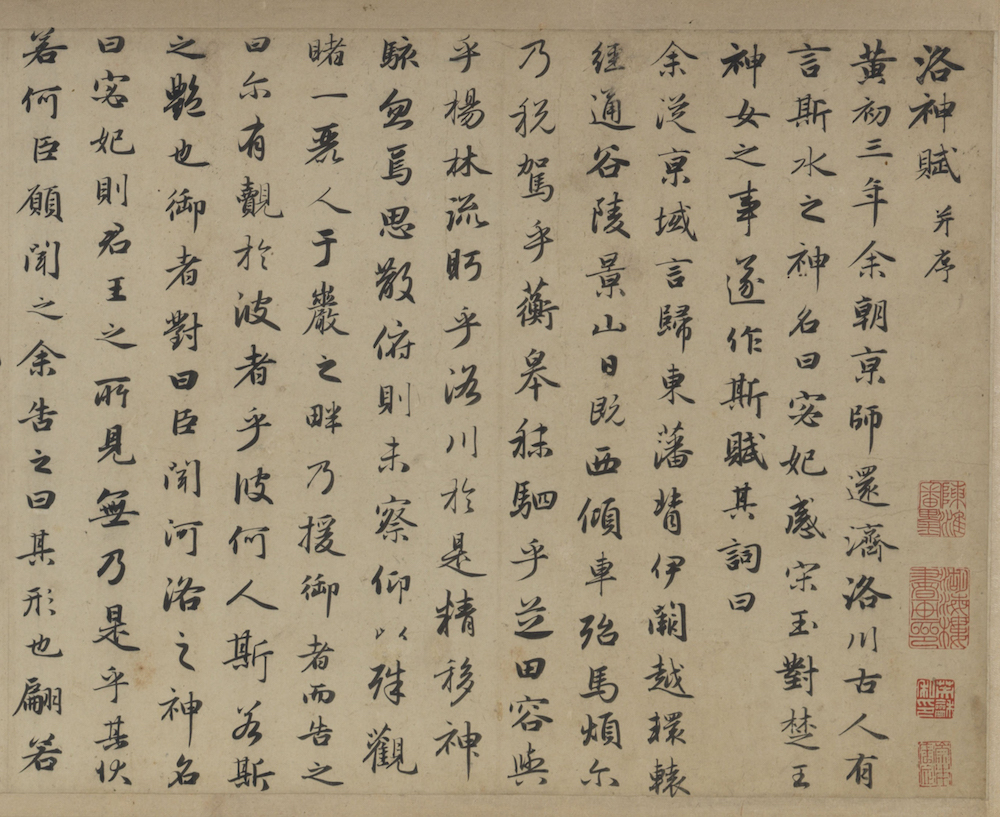
"Luo Shen Fu" volume (part) in running script by Zhao Mengfu, 29.2 cm long and 193 cm wide, made in 1300, collected by Tianjin Museum
Also on display is the volume "Fu on the Goddess of Luo", the representative work of Zhao Mengfu from the Yuan Dynasty, which is a reflection of the historical point in which he advocated the "retroduction" of calligraphy and the "two kings" of patriarchalism, correcting the decadence and reverse of the "Shangyi" style of calligraphy in the late Southern Song Dynasty. .
"Luo Shen Fu" in regular script is now in the Tianjin Museum. It is one of Zhao's representative works. ), the structure is correct and well-proportioned, the posture is graceful and unrestrained, the brushstrokes are graceful and elegant, and the layout is dense and dense. It is restrained in its elegance, and ups and downs in its uprightness. Later generations commented that it was "like a dragon swimming in the clouds."

"Luo Shen Fu" volume (part) in running script by Zhao Mengfu, 29.2 cm long and 193 cm wide, made in 1300, collected by Tianjin Museum
The influence of "Shangyi" calligraphy style on the aesthetics of Ming and Qing calligraphy
The exhibition also displays works by masters of calligraphy art from the mid-Ming Dynasty to the Qing Dynasty. Starting from the "Wumen School of Calligraphy", to the "Eight Eccentrics of Yangzhou" in the early Qing Dynasty, to He Shaoji in the late Qing Dynasty, a large number of brilliant calligraphy innovation masters emerged in the past 400 years. The exhibition includes calligraphy by Zhu Yunming, Chen Chun, Xu Wei, Dong Qichang, Wang Duo, Bada Shanren and others.

Wen Zhengming and Su Shi's "Fu on Red Cliffs" in regular script, paper, 28.6 cm long and 74.5 cm wide, collected by the Palace Museum

Dong Qichang's cursive script Su Shi's "Red Cliff Nostalgia" volume (detail), silk edition, 25.6 cm long and 577 cm wide, collected by Wenzhou Museum
Among them, the large scroll of Xu Wei's "Zi Jin Tang Ji" is on display and is part of the collection of the Palace Museum. "Zijin Tang Ji" was written by Ouyang Xiu for the Zhou Jin Tang built by Han Qi, a famous official in the Northern Song Dynasty. Famous calligraphers in the past dynasties have written "Zi Jin Tang Ji".

Xu Wei's running script of Ouyang Xiu's "Zi Jin Tang Ji" scroll, paper, 182.5 cm long and 48.4 cm wide, collected by the Palace Museum
Xu Wei has a crazy attitude when creating grass. In his paintings, the lines are rough and galloping; the characters are broken up, obeying the overall effect of the work, and abandoning the aesthetic value of local techniques, all for the sake of the overall visual effect. His "destructive" characteristics can be understood from this "Zijintang Ji". The thoroughness of his irrational rebellion was unprecedented and shocked the entire history of calligraphy. After him, people had a new understanding of the aesthetics of calligraphy. After that, a large number of starry expressionist calligraphers appeared in the Ming Dynasty. This group of calligraphers full of romantic artistic colors were all influenced by the "Shangyi" calligraphy style of the Song Dynasty, which pursued individuality, connotation and style, and pushed the art of Chinese calligraphy to one peak after another.

Poetry scroll "Old Work of Worshiping the Bamboo Pavilion in Xiangshan Garden" in running script by Wang Duo, silk edition, 173 cm long and 50.2 cm wide, collected by Tianjin Museum
During the exhibition, the Zhejiang Art Museum will hold supporting thematic cultural activities that express the life aesthetics of the Song Dynasty, such as calligraphy writing, tea ceremonies, incense ceremonies, flower arrangement gatherings, guqin, and drama performances; experts in the cultural history and calligraphy history of the Song Dynasty will be invited to hold academic lectures and special tours. From the perspective of art history, the cultural connotation of "Song Rhythm" is shared with the audience based on the exhibition works.
Note: The exhibition is sponsored by the Propaganda Department of the Zhejiang Provincial Committee of the Communist Party of China, the Zhejiang Provincial Department of Culture and Tourism, and hosted by the Zhejiang Art Museum. The exhibition will last until October 13.
